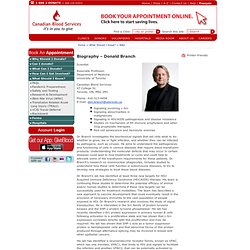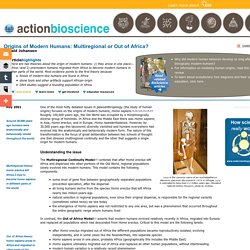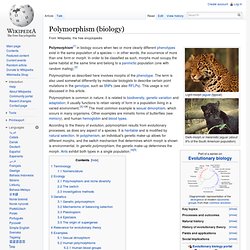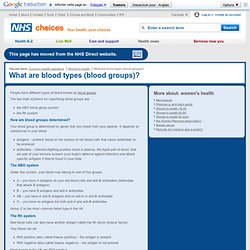

Blood type. Canadian Blood Services - Société canadienne du sang - R&DBioDBranch. Biography – Donald Branch Scientist Associate Professor, Department of Medicine University of Toronto Canadian Blood Services 67 College St.

Toronto, ON, M5G 2M1 Phone: 416-313-4458 E-mail: don.branch@utoronto.ca Signaling involving c-SrcSignaling abnormalities in malignanciesSignaling in HIV/AIDS pathogenesis and disease resistanceStudies on mechanism of Rh immune prophylaxis and other IVIg prophylatic therapiesRed cell senescence and hemolytic anemias Dr. Dr. His lab has identified a neuroendocrine receptor family, known as VPAC, which has one member, VPAC1, that binds to HIV and signals to facilitate the infection and another, VPAC2, that can be externally activated to send an inhibitory signal to stop HIV infection. Dr. Selected Publications: Wang, Q., Rajshankar, D., Branch DR, Abreu, M.T.H., Downey, G.P. and McCulloch, C.A.: Protein tyrosine phosphatase-a and Src functionally link focal adhesions to the endoplasmic reticulum to mediate IL-1 signaling.
Genetics and HIV - Blood Type and HIV. Question: Is there a relationship between genetics and HIV resistance?

Answer: Some people are, in fact, genetically at greater risk of HIV infection than others. The first genetic mutation associated with HIV susceptibility was identified in the mid 1990s. Known as the CCR5-Delta32 mutation, it seems to confer strong resistance to infection by HIV. This gene mutation is found most commonly in certain European populations, possibly because it was also associated with resistance to other diseases such as smallpox or the Bubonic Plague. In early 2009, a paper was published announcing that another genetic mutation may also confer some level of resistance to HIV. Note: The 2009 study has been heavily publicized as saying that your blood type can protect you against HIV.
Sources: Lund N et al. Blood type - new weapon in battle against HIV infection. Cro-Magnon. Cro-Magnon ( i/kroʊˈmænjən/ or US pronunciation: /kroʊˈmæɡnən/; French: [kʁomaɲɔ̃]) is a name that has been used to describe the first early modern humans (early Homo sapiens sapiens) of the European Upper Paleolithic.[1] Current scientific literature prefers the term European Early Modern Humans (EEMH), to the term 'Cro-Magnon,' which has no formal taxonomic status, as it refers neither to a species or subspecies nor to an archaeological phase or culture.[1] The earliest known remains of Cro-Magnon-like humans are radiocarbon dated to 43,000 years before present.[2] The Cro-Magnon are the ancestors of modern Europeans.

Cro-Magnons were robustly built and powerful. The body was generally heavy and solid with a strong musculature. The forehead was fairly straight rather than sloping like in Neanderthals, and with only slight browridges. The face was short and wide. Etymology[edit] Origins of Modern Humans: Multiregional or Out of Africa? May 2001 Lucy is the common name of an Australopithecus afarensis specimen discovered in 1974 in Ethiopia.

Lucy is estimated to have lived 3.2 million years ago. Cleveland Natural History Museum, photo by Andrew. Around 30,000 years ago humans were anatomically and behaviorally similar throughout the world. One of the most hotly debated issues in paleoanthropology (the study of human origins) focuses on the origins of modern humans, Homo sapiens.9,10,3,6,13,15,14 Roughly 100,000 years ago, the Old World was occupied by a morphologically diverse group of hominids.
Understanding the issue Multiregional theory: homo erectus left Africa 2 mya to become homo sapiens in different parts of the world. The Multiregional Continuity Model15 contends that after Homo erectus left Africa and dispersed into other portions of the Old World, regional populations slowly evolved into modern humans. To understand this controversy, the anatomical, archaeological, and genetic evidence needs to be evaluated. Polymorphism (biology) Dark-morph or melanistic jaguar (about 6% of the South American population) Polymorphism[1] in biology occurs when two or more clearly different phenotypes exist in the same population of a species — in other words, the occurrence of more than one form or morph.

In order to be classified as such, morphs must occupy the same habitat at the same time and belong to a panmictic population (one with random mating).[2] Polymorphism as described here involves morphs of the phenotype. The term is also used somewhat differently by molecular biologists to describe certain point mutations in the genotype, such as SNPs (see also RFLPs).
This usage is not discussed in this article. Polymorphism is common in nature; it is related to biodiversity, genetic variation and adaptation; it usually functions to retain variety of form in a population living in a varied environment.[3]:126 The most common example is sexual dimorphism, which occurs in many organisms. G. And in the laboratory: Human blood groups: inheritance and imp... [J Infus Nurs. 2003 Nov-Dec. What are blood types (blood groups)? - Health questions. People have different types of blood known as blood groups.

The two main systems for classifying blood groups are: the ABO blood group system the Rh system How are blood groups determined? Your blood group is determined by genes that you inherit from your parents. Human Blood: ABO Blood Types.